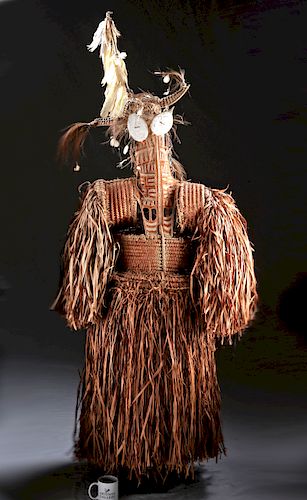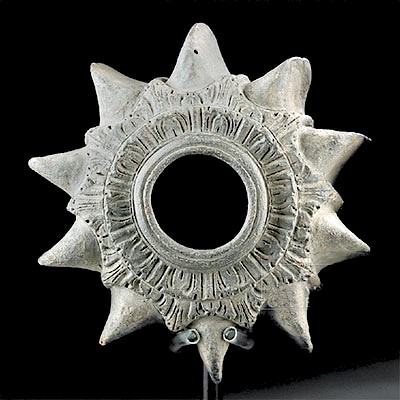Early 20th C. Asmat Fiber Mask - Jipae Festival
Lot 106e
About Seller
Artemis Gallery
686 S Taylor Ave, Ste 106
Louisville, CO 80027
United States
Selling antiquities, ancient and ethnographic art online since 1993, Artemis Gallery specializes in Classical Antiquities (Egyptian, Greek, Roman, Near Eastern), Asian, Pre-Columbian, African / Tribal / Oceanographic art. Our extensive inventory includes pottery, stone, metal, wood, glass and textil...Read more
Estimate:
$1,200 - $1,800
Absentee vs Live bid
Two ways to bid:
- Leave a max absentee bid and the platform will bid on your behalf up to your maximum bid during the live auction.
- Bid live during the auction and your bids will be submitted real-time to the auctioneer.
Bid Increments
| Price | Bid Increment |
|---|---|
| $0 | $25 |
| $300 | $50 |
| $1,000 | $100 |
| $2,000 | $250 |
| $5,000 | $500 |
| $10,000 | $1,000 |
| $20,000 | $2,500 |
| $50,000 | $5,000 |
| $100,000 | $10,000 |
| $200,000 | $20,000 |
About Auction
By Artemis Gallery
Jul 25, 2019
Set Reminder
2019-07-25 10:00:00
2019-07-25 10:00:00
America/New_York
Bidsquare
Bidsquare : Pre-Columbian | Tribal | Ethnographic
https://www.bidsquare.com/auctions/artemis-gallery/pre-columbian-tribal-ethnographic-4291
Featuring ancient and ethnographic art from around the world, including Pre-Columbian, Native American, African / Tribal, Ethnographic, Spanish Colonial, Fossils, Fine Art, much more. Many Oceanic pieces from an important Tucson, Arizona collection, first time at auction!! Artemis Gallery info@artemisgallery.com
Featuring ancient and ethnographic art from around the world, including Pre-Columbian, Native American, African / Tribal, Ethnographic, Spanish Colonial, Fossils, Fine Art, much more. Many Oceanic pieces from an important Tucson, Arizona collection, first time at auction!! Artemis Gallery info@artemisgallery.com
- Lot Description
Indonesia, western Irian Jaya/West Papua, Asmat people, ca. early to mid 20th century CE. A beautifully preserved example of a Jipae festival body mask. A woven basketry bodice, dangling sago leaves sleeves and skirt, and a woven head piece with protruding, stalk-like wooden eyes painted white form the mask, which is also known as a doroe or dekewar. Cassowary feathers decorate woven projections from the sides of the head, while thick white feathers hang from a wooden stalk that rises from the top of the head. Ceramic beads hang in short cords from the sides of the face. A white and pale red-brown color scheme dominates, with alternating vertical and horizontal lines on the woven shoulders, torso, neck, and face. Size: 13.5" L x 24" W x 48" H (not including the dangling skirt) (34.3 cm x 61 cm x 121.9 cm); 78" H (198.1 cm) on included custom stand.
Masks in the Jipae festival represent the deceased. The Asmat dance the ceremony to urge these ancestors to return to the "safan", the world of the ancestors. Fascinatingly, each mask corresponded to a specific deceased member of the community, and the dancer wearing the mask had agreed to take on the responsibilities of the deceased, including caring for their children.
See a very similar mask at the British Museum: https://www.britishmuseum.org/research/collection_online/collection_object_details.aspx?objectId=491968&partId=1
Provenance: private Tucson, Arizona, USA collection, acquired between 1950 and 1985
All items legal to buy/sell under U.S. Statute covering cultural patrimony Code 2600, CHAPTER 14, and are guaranteed to be as described or your money back.
A Certificate of Authenticity will accompany all winning bids.
We ship worldwide and handle all shipping in-house for your convenience.
#147695Excellent condition with light wear commensurate with age. Some of the feathers are slightly bent with small losses. Light patina on the beads.Condition
- Shipping Info
-
All shipping is handled in-house for your convenience. Your invoice from Artemis Gallery will include shipping calculation instructions. If in doubt, please inquire BEFORE bidding for estimated shipping costs for individual items.
-
- Buyer's Premium



 EUR
EUR CAD
CAD AUD
AUD GBP
GBP MXN
MXN HKD
HKD CNY
CNY MYR
MYR SEK
SEK SGD
SGD CHF
CHF THB
THB














